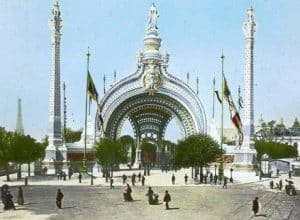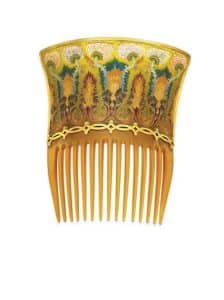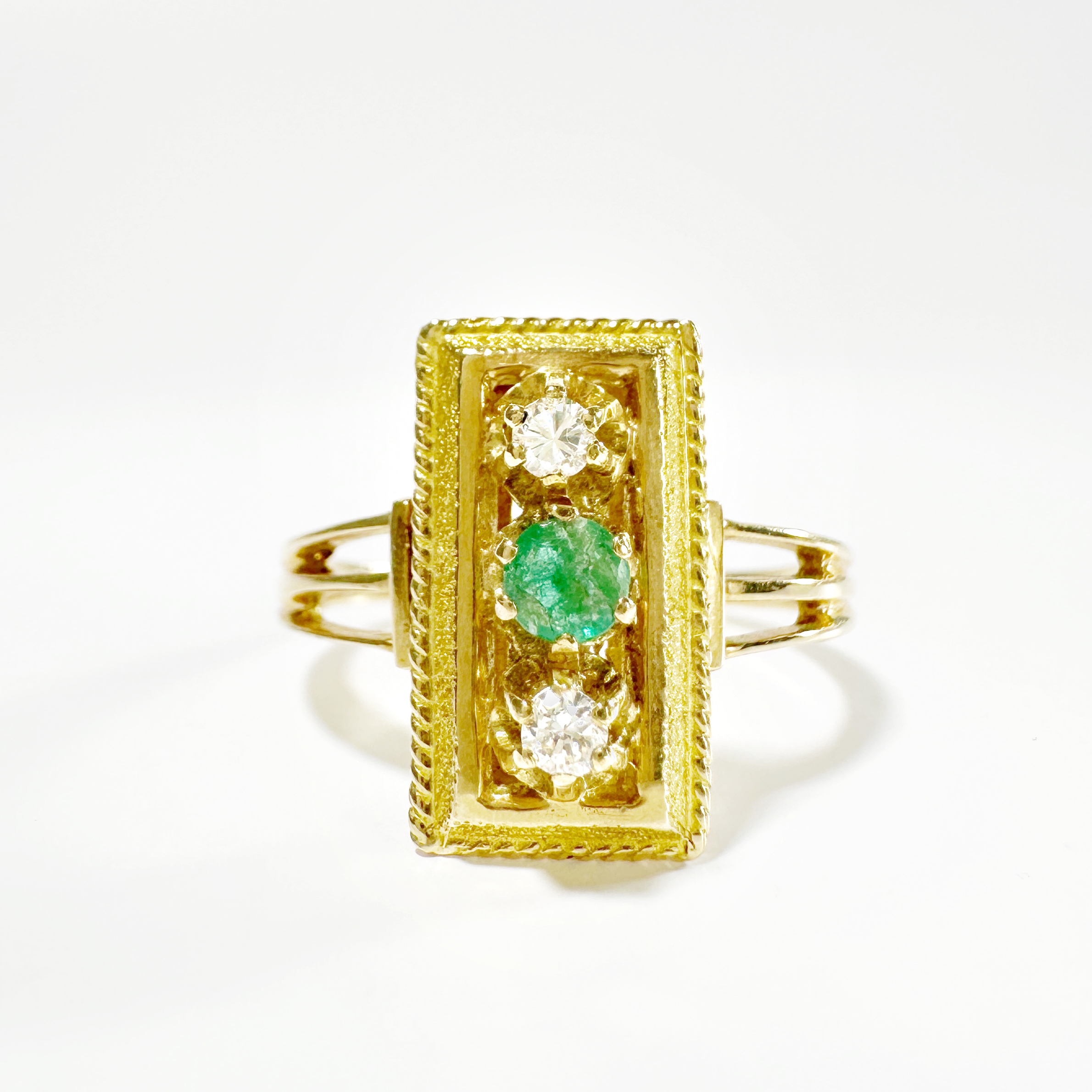When we talk about antique and vintage jewelry, we spontaneously think of the Art Nouveau or Art Deco style. However, we don’t necessarily know what these aesthetics actually entail. This is what we will explore in this article, dedicated to the beauty of the Art Nouveau style.
WHAT DEFINES ART NOUVEAU JEWELRY?
 Art Nouveau jewelry is a style of jewelry that was created during the movement of the same name, which began in the 1890s and continued until World War I. Jewelry is characterized by its fluid and organic shapes, asymmetrical designs and unconventional materials. Art Nouveau jewelry is often inspired by what is sometimes called the “3 Fs”: flora, fauna and feminine figure
Art Nouveau jewelry is a style of jewelry that was created during the movement of the same name, which began in the 1890s and continued until World War I. Jewelry is characterized by its fluid and organic shapes, asymmetrical designs and unconventional materials. Art Nouveau jewelry is often inspired by what is sometimes called the “3 Fs”: flora, fauna and feminine figure
ART NOUVEAU JEWELRY AROUND THE WORLD
Although the movement originated in Europe, it quickly spread across the globe and gave rise to a myriad of different variations. In France, Art Nouveau was marked by its use of sinuous curves and elaborate floral motifs. In Belgium it took on a more graphic and geometric quality. In Germany, it is called Jugendstill but also Reformstil or Secessionsstil, to identify this “fin de siècle” aesthetic. In Italy, Art Nouveau appeared under the generic names Floreale, Arte nuova and Stile Liberty at the end of the nineteenth century.
In the UK, Art Nouveau was heavily influenced by the Arts and Crafts movement, which led to a focus on handmade objects and a rejection of mass production.
AN ARTISTIC MOVEMENT INSPIRED BY SCIENCE AND INDUSTRY
A mid the rapid social and cultural changes in the 19th century, artists sought stability and inspiration by delving into history. They longed for a past where artistic boundaries were fluid, leading them to study art history and reinterpret bygone styles. Additionally, with colonial expansion, artists became captivated by products from the Far East brought back from distant lands. Knowledge was spreading quickly during this time, thanks to numerous popular scientific events and publications that reached a broad audience.
mid the rapid social and cultural changes in the 19th century, artists sought stability and inspiration by delving into history. They longed for a past where artistic boundaries were fluid, leading them to study art history and reinterpret bygone styles. Additionally, with colonial expansion, artists became captivated by products from the Far East brought back from distant lands. Knowledge was spreading quickly during this time, thanks to numerous popular scientific events and publications that reached a broad audience.
The era also witnessed the rise of Universal Exhibitions. The 1900 edition, themed “Evaluation of a century,” showcased astonishing scientific advancements promising material progress. These wonders, made accessible through the latest technology, sparked interactions between art, science, and industry.
THE MATERIALS OF ART NOUVEAU
 Art nouveau jewelry exemplifies the notion that beauty in an object comes from its artistic design and not simply the value of its materials. This new aesthetic, present across various art forms, features feminine silhouettes, scrolls, flowers, insects, and enchanting arabesques, achieved through a skillful combination of stones, metals, and materials of different worth.
Art nouveau jewelry exemplifies the notion that beauty in an object comes from its artistic design and not simply the value of its materials. This new aesthetic, present across various art forms, features feminine silhouettes, scrolls, flowers, insects, and enchanting arabesques, achieved through a skillful combination of stones, metals, and materials of different worth.
During the Art Nouveau period, jewelers began to move away from traditional materials like gold and silver. They experimented with new materials such as enamel, glass, and horn. The use of piqué-à-jour enamelling, a technique that creates the illusion of stained glass, has become particularly popular. Art Nouveau jewelers have also incorporated unconventional materials like ivory, tortoiseshell and mother-of-pearl to create unique and striking pieces. Gemstones such as opals, moonstones, and pearls were also popular choices, as their iridescent qualities complemented the flowing lines and organic shapes of the Art Nouveau style.
ART NOUVEAU AND THE CELEBRATION OF NATURE
 Art Nouveau jewelry is known for its distinctive design features that make it instantly recognizable. This style is characterized by its use of fluid and organic lines, asymmetrical shapes and patterns inspired by nature. Art Nouveau jewelry often features intricate patterns of flowers, vines, and insects, which are crafted in a way that emphasizes the natural beauty of these forms. The use of gemstones is also a key part of Art Nouveau jewelry, with jewelers often incorporating them into their designs in creative ways, for example by setting the eyes of a dragonfly or the body of a snake with gems.
Art Nouveau jewelry is known for its distinctive design features that make it instantly recognizable. This style is characterized by its use of fluid and organic lines, asymmetrical shapes and patterns inspired by nature. Art Nouveau jewelry often features intricate patterns of flowers, vines, and insects, which are crafted in a way that emphasizes the natural beauty of these forms. The use of gemstones is also a key part of Art Nouveau jewelry, with jewelers often incorporating them into their designs in creative ways, for example by setting the eyes of a dragonfly or the body of a snake with gems.
AN ODE TO THE FEMALE BODY
 The female figure is a recurring motif in Art Nouveau jewelry, reflecting the celebration of sensuality and the natural world in motion. The curved lines and flowing shapes of Art Nouveau are often used to depict women. Featured in various poses, it emphasized their beauty and grace. Often, these figures are adorned with flowers, leaves, or other natural elements, further emphasizing their connection to the natural world. Art Nouveau jewelry also frequently features depictions of mythical or fantastic female creatures, such as mermaids or fairies, that embody a sense of mystery and enchantment. The use of the female body in Art Nouveau jewelry not only reflects the aesthetic values of the movement, but also a broader cultural shift. Indeed, society veered towards the adoption of femininity and sensuality in the late 19th and early 20th centuries..
The female figure is a recurring motif in Art Nouveau jewelry, reflecting the celebration of sensuality and the natural world in motion. The curved lines and flowing shapes of Art Nouveau are often used to depict women. Featured in various poses, it emphasized their beauty and grace. Often, these figures are adorned with flowers, leaves, or other natural elements, further emphasizing their connection to the natural world. Art Nouveau jewelry also frequently features depictions of mythical or fantastic female creatures, such as mermaids or fairies, that embody a sense of mystery and enchantment. The use of the female body in Art Nouveau jewelry not only reflects the aesthetic values of the movement, but also a broader cultural shift. Indeed, society veered towards the adoption of femininity and sensuality in the late 19th and early 20th centuries..
The Art Nouveau movement had a profound impact on the j1ewelry world and continues to inspire designers and collectors today. The movement’s focus on natural shapes, flowing lines, and innovative use of materials revolutionized the world of jewelry design, and its influence can still be seen in contemporary jewelry. From the use of enamel and gemstones to the incorporation of the female figure, the distinctive elements of Art Nouveau have become iconic, representing a unique and romantic style that continues to captivate and inspire.
 en
en
 Français
Français


